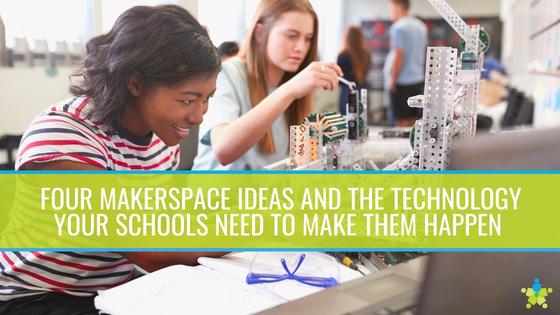[vc_row][vc_column][vc_column_text]Makerspaces are sprouting up everywhere in K-12 schools, and for good reason. Makerspaces engage students in ways that standard classrooms can't. With a makerspace, students are encouraged to try new things, persist through their failures, stay focused on a single project, and work with their hands. These are important behaviors for young learners.
The
benefits of a makerspace are considerable, but some districts have questions about how to set them up and how to afford them. Part of the makerspace magic, though, is that schools can be creative in how they put one together. No matter what your school's budget or floorplan looks like, there's a space somewhere for making.
Here, we've included four makerspace ideas that can be adapted for most K-12 schools, even if you're just getting started with makerspaces.[/vc_column_text][/vc_column][/vc_row][vc_row][vc_column][vc_column_text]
Idea 1: Combine a Digital Display with Low-Tech Tools and Projects
If you can make something with it, you can use it in a makerspace. That includes low-tech learning materials like:
- Paint
- String and yarn
- Paper products, like construction paper and cardboard
- Modeling clay
- Pipe cleaners
- Duct and scotch tape
- Toothpicks
- Straws
The list goes on, and you can include as many or as few materials as your space allows. Once you've got your materials together, consider adding a digital display to the space. A digital display makes it simple for educators to find and deliver creativity-focused projects. As long as a teacher is available to curate the videos, a digital display provides students with multimodal learning opportunities.
Even with a digital display, you don't need much room to pull this idea off. If your school can't dedicate an entire room for makerspace purposes, this idea can work just as well in the library or even in the corner of a classroom. Many teachers like to rotate their students through multiple activities during class, and making something can be one of those activities.
[/vc_column_text][vc_column_text]
Idea 2: Turn a Library into a Research and Collaboration Hotspot
Libraries are the ideal starting point for any project that requires research. Whether it's engineering, science, design, architecture, or just plain crafting. Libraries offer a treasure trove of information for
makerspace students.
Unsurprisingly, many schools are making their libraries the focal point for makerspace activities. It helps that the typical school library is a large place with room to fit a lot of kids and a lot of makerspace supplies.
If your school is also targeting its library for makerspace purposes, consider establishing a room-within-a-room just for creating. There are two reasons for this. One, separating the makerspace from the rest of the library will contain any making-related messes (easier clean up). Two, with a space for making and a space for research, students are encouraged to gather information from the library's research resources and then put that information to use.
An
interactive display is the perfect AV solution for this idea. With an interactive display, students can work together while whiteboarding their projects. Sketch them out, put together a project plan, delegate parts of the process to each student, and watch them explore as a team.
[/vc_column_text][vc_column_text]
Idea 3: Encourage Group Work by Dividing a Makerspace into Pods
Teamwork and group work are points of emphasis in many makerspaces.
AV technology and makerspace furniture can help reinforce those points by encouraging better collaboration.
If you've got an expanded space to work with (the school library is, again, a good choice), then create pods where small groups of students can work together. There is even makerspace furniture designed to facilitate this. One example is Spectrum's Aspire line of desks, which are shaped to fit together in a variety of combinations, no matter how many students are in each group.
At each pod, an interactive display can be used to visualize project details, like in the example above. If you don't have budget room for interactive displays, standard digital displays and a document camera at the front of the room can also be effective. The document camera's feed can be routed to each pod's display, so instructors can introduce concepts with up-close physical examples that everyone can see.
This idea takes a bit more room to pull off. And in large spaces, audio enhancement is another technology to consider.
Audio enhancement solutions can be as simple as a worn microphone and a speaker sitting on a shelf. The effects of better audio can't be overestimated as high activity spaces (like a makerspace) will drown out a teacher's best attempts to speak above the noise. Audio enhancement solutions allow educators to teach without straining their voice.
[/vc_column_text][vc_column_text]
Idea 4: Add Another Dimension to STEM Instruction with AR and VR Technologies
Augmented reality (AR) and virtual reality (VR) solutions are already establishing themselves in the professional world, where they make excellent training tools.
ClassVR and zSpace are two examples of AR and VR in the classroom, and while they can be used for a variety of lessons, they are particularly effective makerspace tools.
With AR and VR technology, your students can visualize engineering and technical concepts in a way they've never seen before, with detailed, 3D exploration. AR and VR can be an engaging and inspiring primer before each makerspace lesson, as they can introduce concepts relevant to the lesson and provide a starting point for creation.
[/vc_column_text][/vc_column][/vc_row][vc_row][vc_column][vc_column_text]
You Don't Need a Big Budget to Bring Big Makerspace Ideas to Life
Makerspaces are an effective way to deliver STEM curriculum, providing students with a different approach to learning than they would get in a traditional classroom. Even better, makerspaces are infinitely customizable. If your school is just getting started, low-tech materials may be plenty. As your makerspace efforts develop, adding in AV solutions like interactive displays,
robotics kits,
document cameras and supporting furniture can take it to new heights.[/vc_column_text][/vc_column][/vc_row]



